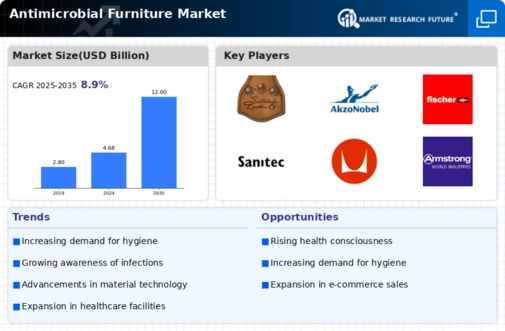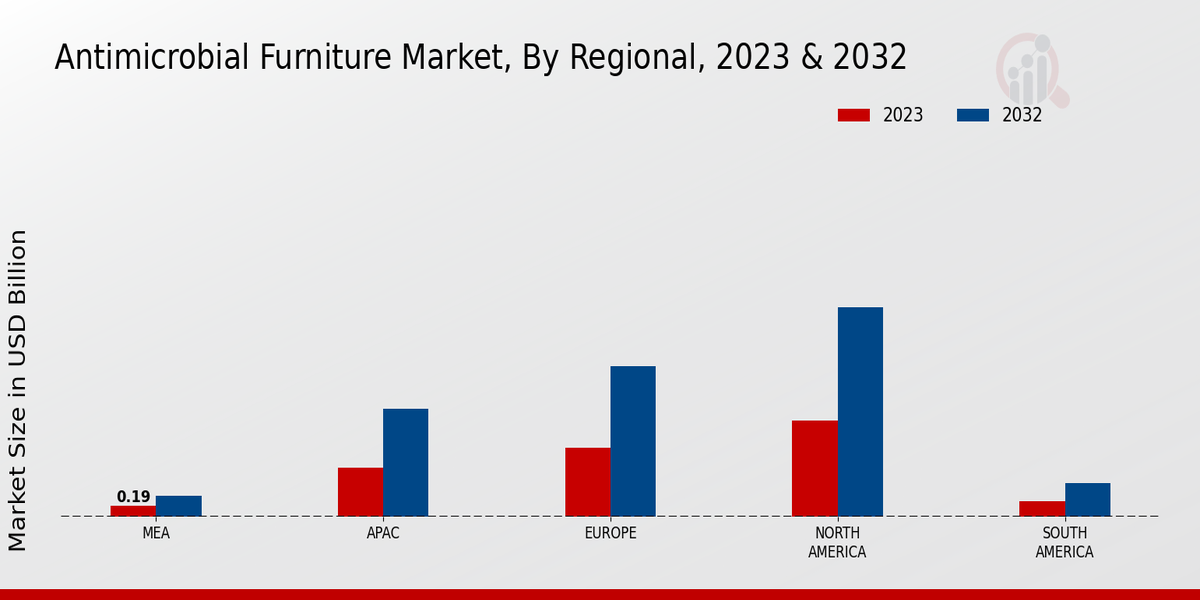Regulatory Support
Government regulations and standards promoting hygiene and safety in public spaces are likely to bolster the Global Antimicrobial Furniture Market Industry. Various health organizations advocate for the use of antimicrobial materials in environments such as hospitals and schools to mitigate the spread of infections. Compliance with these regulations often necessitates the adoption of antimicrobial furniture, thereby driving demand. For instance, guidelines from health authorities may encourage the use of such materials in high-traffic areas. This regulatory support not only enhances consumer confidence but also stimulates market growth, as manufacturers align their products with these standards to meet the evolving needs of consumers.
Diverse Applications
The versatility of antimicrobial furniture across various sectors is a key driver for the Global Antimicrobial Furniture Market Industry. This type of furniture finds applications in healthcare facilities, educational institutions, commercial spaces, and residential settings. Each sector presents unique challenges and requirements, which antimicrobial furniture can effectively address. For instance, in healthcare settings, the need for infection control is paramount, while in schools, reducing the spread of germs among children is critical. The ability to cater to diverse needs enhances the market's appeal and encourages broader adoption. As awareness of the benefits of antimicrobial furniture continues to grow, its applications are expected to expand, further driving market growth.
Sustainability Trends
The increasing emphasis on sustainability and eco-friendly products is shaping the Global Antimicrobial Furniture Market Industry. Consumers are becoming more discerning, seeking furniture that not only offers health benefits but also aligns with environmental values. Manufacturers are responding by developing antimicrobial furniture using sustainable materials and processes. For example, furniture made from recycled materials that incorporate antimicrobial properties appeals to environmentally conscious consumers. This trend is likely to drive market growth as more individuals and organizations prioritize sustainability in their purchasing decisions. The intersection of health and environmental consciousness may further enhance the appeal of antimicrobial furniture in the coming years.
Rising Health Awareness
The increasing global focus on health and hygiene is a primary driver for the Global Antimicrobial Furniture Market Industry. As consumers become more aware of the importance of maintaining clean environments, the demand for antimicrobial furniture is likely to rise. This trend is particularly evident in sectors such as healthcare, education, and hospitality, where the risk of infection is heightened. For instance, antimicrobial surfaces can reduce the presence of harmful bacteria by up to 99.9 percent, making them an attractive option for facilities aiming to enhance safety. This growing awareness is projected to contribute to the market's growth, with an estimated value of 4.68 USD Billion in 2024 and a potential increase to 12.0 USD Billion by 2035.
Market Growth Projections
The Global Antimicrobial Furniture Market Industry is poised for substantial growth, with projections indicating a market value of 4.68 USD Billion in 2024 and an anticipated increase to 12.0 USD Billion by 2035. This growth trajectory suggests a robust demand for antimicrobial solutions across various sectors, driven by factors such as health awareness, technological advancements, and regulatory support. The compound annual growth rate of 8.92% from 2025 to 2035 reflects the increasing integration of antimicrobial properties in furniture design and manufacturing. As the market evolves, stakeholders are likely to explore innovative solutions to meet the rising expectations of consumers.
Technological Advancements
Innovations in material science and manufacturing processes are significantly influencing the Global Antimicrobial Furniture Market Industry. The development of advanced antimicrobial coatings and treatments allows for the integration of protective features into various types of furniture. For example, the use of silver nanoparticles in coatings has shown promising results in inhibiting microbial growth. These technological advancements not only enhance the functionality of furniture but also expand its application across diverse sectors, including residential, commercial, and institutional settings. As a result, the market is expected to experience a compound annual growth rate of 8.92% from 2025 to 2035, driven by the continuous evolution of antimicrobial technologies.



 Source: Primary Research, Secondary Research, MRFR Database and Analyst Review
Source: Primary Research, Secondary Research, MRFR Database and Analyst Review


















Leave a Comment